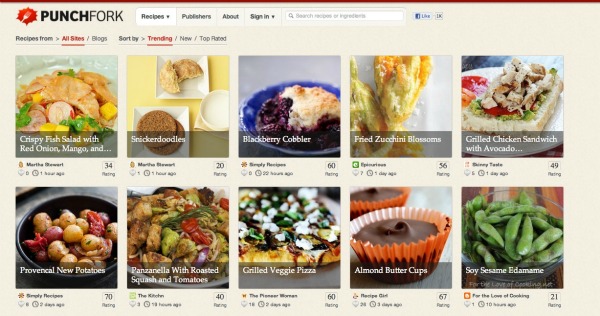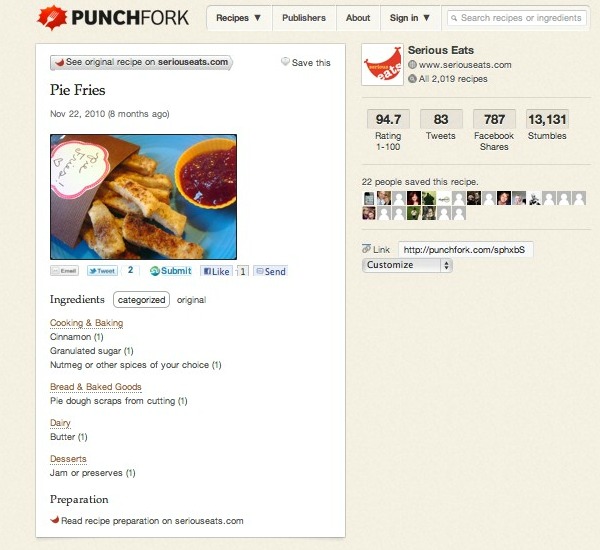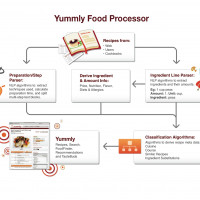How can data exhaust produced through social networks be leveraged to improve web search? What business models are emerging based on the monetization of digital assets, rather than the reliance on advertising dollars? For the past year and a half, these two questions have been at the forefront of my mind as I’ve explored the ways people are and could leverage real-time, incidental data to empower better decision-making across the food system, as well as new business models for journalism.
In the food world, there have been a number of innovations related to managing the deluge of recipes available on the web through improved search and curation. For example, FoodPress and Gojee aggregate the best recipes from food bloggers across the web. Food52 and RecipRelay crowdsource recipes through the social networks they have developed. Yummly and Google aggregate recipes, using semantics and algorithms to allow for highly granular filtration and customization. Gourmet Live is exploring new media business models by combining social gaming and premium real-time recipes and stories.
Punchfork, a site that uses social data to make it easier to find the ‘best’ recipes from popular blogs and sites, is betting on a new model. Inspired by a bit.ly API competition, Punchfork founder Jeff Miller aggregates the recipe mentions of participating recipe publishers from across Twitter, Facebook, and Stumbleupon, and then rates recipes according to the number of shares. The impressive list of 33 publishers currently includes sites such as Food52, Martha Stewart, Chow.com, Allrecipes, Smitten Kitchen, Serious Eats, among others. While not a perfect indicator, Punchfork founder Jeff Miller sees the number of times a recipe is shared across social networks as “social proof” that a given recipe is worth trying.
Like media websites, monetizing a recipe website is immensely challenging, leaving most relying on advertising. Punchfork takes a different approach by offering paid access to their API, which allows developers to easily integrate recipes from all of Punchfork’s participating publishers into their own website or app. In the future, Miller hopes to leverage data about a user’s tastes to provide them with targeted coupons and other offers. This would also result in an opportunity to link the actual purchase of an ingredient with recipes, something I am surprised no one else is doing (at least to my knowledge).
My interest was immediately piqued when I learned of how Punchfork leverages incidental social data to innovate the recipe search experience and I have continued to be impressed with Miller’s forward-thinking business model. I had a chance to speak with Miller and learn more about Punchfork, his business model, lessons learned in building a data-driven startup, and the opportunities he sees for food and tech to revolutionize the food system.
_____________________________________
Danielle Gould: What was the inspiration behind Punchfork?
Jeff Miller: The inspiration for Punchfork came from the foodie magazines at the grocery checkout line. There’s something very tantalizing and thrilling about leafing through page after page of delicious-looking pictures of food. The idea for Punchfork was simply to take that experience of browsing amazing food photos, relocate it to the web, and blow it up 1,000 times larger with an automated feed of real-time recipes from the best food bloggers.
The problem is that nobody wants to read a magazine with 50,000 pages. There has to be some form of curation involved.
I was mulling over how I could make this idea work, and around the same time (this was near the end of 2010) I had also been doing a side project for the bit.ly API Contest held every year by Betaworks. The app I created took statistics from the gazillions of bit.ly links shared on Twitter and figured out which news stories were most popular on the web at any given moment. Trending news, curated by Twitter, essentially. I thought, why not just apply this technique to recipes? After a few tweaks, that led to the current incarnation of Punchfork.
Actually, I still own the specific issue of Cook’s Illustrated that started me down this path. The back page has this incredible grid display of holiday cakes, cookies and other treats. It looks a lot like the Punchfork home page.
DG: How does the site work?
JM: Punchfork ranks the most popular recipes around the web and presents them in a beautiful magazine-like visual layout. We rate recipes based on the number of shares on Twitter, Facebook and other social networks, so the higher a recipe’s score, the more it’s been talked about and shared on the web.
You can search the site by ingredient, perhaps to find a use for those leftovers in your fridge. You can also search by the name of a dish, or a general category like fish or pasta. The site keeps track of any favorites you save so you can come back to them later.
Besides sorting recipes by popularity, you can also easily discover new recipes and see what’s trending on food blogs and recipe sites.
DG: What differentiates Punchfork from other recipes websites? How are you using ‘social data’ to innovate the recipe search experience?
JM: Curation. Gone are the days when a site can boast about having a million recipes in their database. There’s no value in that. Users want curated, personalized, high quality results. We use social networks as the catalyst for solving this problem.
Social data is the core of Punchfork. On traditional recipe sites, you’re presented with page after page of search results in no discernible order. With Punchfork, you see only the highest quality recipes because they’ve been shared all over Twitter and Facebook. It’s a form of social proof. Social data is not a perfect measure by any means, but it does do a surprisingly effective job of revealing mass preference. Our users tell us it’s very handy to be able to search for a dish, chili let’s say, and immediately see the most popular chili recipe on the web.
Punchfork is real-time. Food bloggers are constantly innovating and churning out fresh recipes, and we keep up with them by discovering new recipes often just moments after they’re published.
Besides our focus on social data, there are some low-key features of punchfork.com that we believe make a difference to users, like converting ingredient lists into a categorized, easy-to-read form.
DG: Could you describe the three iterations your site has gone through and how market demand influenced each version?
JM: Sure. The first iteration of Punchfork was a fancy productivity application for home cooks. The app was going to do meal scheduling, pantry management, automated dinner suggestions and a few other futuristic-sounding things. However, not many people it seems are that systematic about managing what they eat, with the possible exception of large families. For the majority of folks I encountered, meals happen more on-the-fly. It’s common to arrive at the grocery store with no idea of what to cook and whip out one’s iPhone to Google up some recipes. This realization forced me to move on to a different idea.
Punchfork has a fairly advanced ingredient parser under the hood, so next I tried to use that to make a grocery list app. You could copy and paste recipes from anywhere on the web and get back a beautifully formatted and categorized shopping list. I circulated a prototype of that app to a group of testers. The feedback was that it was a neat app and a few people might use it, but at the end of the day there just wasn’t anything singularly compelling about it. Not to mention the fact that there are hundreds of grocery list makers already on the App Store.
Finally I hit upon the social recipe ratings idea, and that led to the third and current iteration of Punchfork. It became obvious pretty quickly that people are extremely interested in discovering great recipes.
DG: What is your business model?
JM: In the near term our business model is the Punchork API, which has premium (paid) access tiers.
Over time, I see us branching out into grocery coupons and other targeted offers. The food vertical lends itself naturally to capturing user’s tastes, so I think there is a pretty clear opportunity there to match up demand with offers.
I’m tremendously interested in ways to directly link recipe discovery with the actual purchasing of ingredients. The grocery industry in the U.S. isn’t quite ready for that yet, technologically speaking, but as food tech continues to heat up I think we will see some convergence there that will create new opportunities.
DG: You recently released an API. What was your motivation for doing so?
JM: The goal of the Punchfork API is to give other developers the ability to painlessly integrate recipes into their own applications.
The Punchfork API makes our curated recipe database available to any app. Web, iPad, mobile, you name it–anything that speaks HTTP can use our API. An internet fridge could use our API. We provide rich metadata for each recipe, including categorized ingredients and a thumbnail photo of each dish, and our social recipe ratings are available to help developers emphasize high-quality recipes in their apps. The API has a free plan that anyone can sign up for and start using right away.
After we launched the API, the response from app developers was a lot more intense than we had anticipated. Turns out there are a lot of food-related apps and sites out there who want recipes in their product, but don’t have the resources to create a recipe database themselves, and Punchfork was first to market with a recipe API.
At heart, I’m a data guy and a huge believer in the power of data. But data by itself is just raw material; it’s the developers who unlock the value of data by combining it with other sources, remixing it, presenting it in unique ways, etc. Our site punchfork.com is just one among thousands of possible recipe applications. I’m excited to see what amazing things people will cook up with the Punchfork API.
DG: How are people using the API?
JM: I like the way AnyLeaf, a Y Combinator-backed grocery deal site, is using our API to show recommended recipes next to sale items. I was on their site the other day and saw that ground turkey was on sale at my local Safeway. Right alongside there was a top-rated Food Network recipe for turkey chili. That kind of integration is a clear value-add for users, and also a clever way for AnyLeaf to increase site engagement.
DuckDuckGo is using the Punchfork API to embed recipes directly into their search results. (TIME Magazine called DuckDuckGo the “In-N-Out Burger of search engines”, so I think it’s a nice match with Punchfork!) Go to duckduckgo.com and just type a few ingredients into their search box, and you’ll immediately see the top 3 recipe results from Punchfork without having to click through to a new page. Users love the immediacy of it, and recipe search has already become one of the most popular features on DuckDuckGo.
Other developers have apps under way that will make use of our API in some unique ways. We hope to make more announcements soon.
DG: What incentives do bloggers and recipe providers have for working with you?
JM: My experience is that food bloggers want, above all, for people to read, cook, and enjoy their recipes. Punchfork helps make that happen in a variety of ways.
Search is obviously a major conduit. Each publisher’s complete set of recipes becomes searchable by ingredient, simply by being on Punchfork. So when a user comes along and searches for a dish they’re craving, they might become a fan of a new recipe blog that they’ve never seen before.
The user experience on punchfork.com funnels traffic naturally back to our bloggers. For example, we never republish preparation steps on our site; instead we direct the user back to the recipe source. We also raise visibility for each blogger’s brand by prominently displaying their name and linking to their site wherever possible.
Our social recipe ratings can be used by publishers to see which of their recipes have the highest engagement from users. That’s pretty powerful data that’s hard to find elsewhere.
Lastly, our Recipe API is a unique way for food bloggers to get their recipes in wider syndication. The API generates traffic bloggers wouldn’t have otherwise received. We think that over time, as we continue to add more partnerships, this API channel will become pretty powerful.
It’s super easy for any food blogger or recipe publisher to work with Punchfork. They don’t need special markup on their recipe pages. We do all the integration work on our end.
DG: What gets you most excited about food and tech?
JM: There are two trends I’m very excited about in food tech right now. One is the increasing interconnectedness of the food system. We need to get data flowing between farmer’s markets and recipe sites, from recipe sites to grocery stores, and grocery stores to mobile shopping apps. This is how the next wave of entirely new products will be enabled, especially on the commerce end of the spectrum. And I may sound like a broken record talking about APIs all the time, but APIs definitely play a major role in this.
The other trend I’m excited about is personalization. When I search for a dish on Punchfork, I want to be shown recipes that speak to my tastes, not just the same results as everyone else. True personalization goes beyond “I don’t like cilantro” or “I have leftover spinach in my fridge”. It looks at your actual behavior to uncover linkages that are not expressed directly. But it’s a very subtle problem, and one of the reasons is true personalization requires maintaining some degree of randomness and serendipity. (Otherwise, if you like tuna, you’ll just be shown tuna casserole over and over again.) Personalization will be the foundation of the next iteration of Punchfork.









